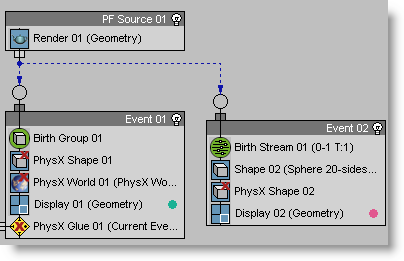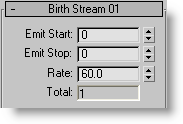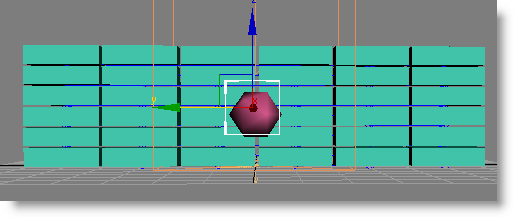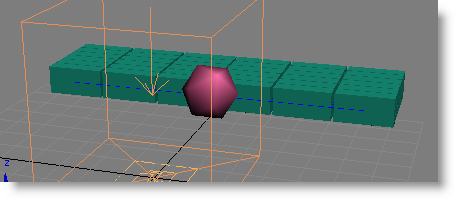To create particle interaction, you'll add a Birth Stream emitter, another of the new operators.
-
From the depot, drag a Birth Stream operator next to Event 01 so it creates a new event. Set the Display operator to Geometry, and then add a Shape operator and a PhysX Shape operator after Birth Stream, both set to Sphere. Wire the event to the PF Source global event.
Important: Makes sure the Shape operator precedes the PhysX Shape operator in the event. Because event elements are handled in order from top to bottom, the Shape data must be available for PhysX Shape to process; otherwise it won't work correctly.

You also need to clone the PhysX World operator so both events use the same PhysX World helper and world setup.
-
Click the Birth Stream operator and set Emit Stop to 0, so that all particles are emitted at once at the start of the animation.
The read-only Total field should now contain 1.

If you play the animation now, you should see the single particle come shooting out from under the wall. That's because the default position of the Birth Stream icon is at the world center: (0,0,0). Also, because Birth Stream has a Speed property built in, set to 300 by default, no additional Speed operator is necessary.
-
Select the Birth Stream icon and move it about 80 units in the negative X direction, and then move it upward so it's vertically centered on the wall height. The position should be about (-80,0,15).

-
Click the Shape operator and set the Size to 20, so the sphere is relatively large.
-
Play the animation.
The sphere goes through the wall without colliding with the bricks. That's because its event isn't participating in the physics simulation ... yet.
-
In Event 01, click the PhysX World operator, right-click, and choose Copy. Then right-click in Event 02 just above the Display operator and choose Paste Instanced.
The PhysX World needs to be in every event whose particles should participate in the simulation, and it should always be the last operator in the event except for Display and any tests. If it's not in the right place, move it there.
-
Play the animation again.
This time the sphere knocks the wall down. Depending on your setup, it might also then push the wall along as it rolls. Note that the particles remain bound together tightly even when struck by the ball.

If you're not getting the right results, save your work and take a look at the included file Box2_tutorial1.max. Check its settings to see what's different from your setup.